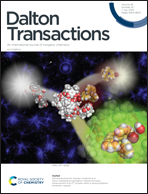More efficient spin–orbit coupling: adjusting the ligand field strength to the second metal ion in asymmetric binuclear platinum(ii) configurations†
Abstract
Two types of asymmetric binuclear platinum(II) complexes (Pt-1 and Pt-3) bearing bridging ligands of 2-(2,4-difluorophenyl)-5-(pyridin-2-yl)pyridine and 2-(2,4-difluorophenyl)-4-(pyridin-2-yl)pyridine as well as their corresponding mononuclear counterparts (Pt-2, Pt-4, and Pt-5) were synthesized and characterized. Different chelating constructions of the second platinum(II) ions and the bridging ligands in Pt-1 and Pt-3 gave rise to two kinds of electron-transition pathway during their photophysical processes. The meta-/para-carbon of nitrogen on the center pyridyl segments set different levels of ligand field strength to the second platinum(II) ions, lowering their occupied d orbital to varying degrees. Pt-1 showed an enhanced spin–orbit coupling (SOC), caused by the additional metal component through direct orbital hybridization at higher states, where the fixed molecular skeleton induced by the additional metal–ligand bonding also helped to suppress molecular distortion in the excited state, ensuring a high quantum yield (Φ, 0.89 in toluene), which is among the best results in bimetallic complexes. While the second platinum(II) ion in Pt-3 seemed to make no contribution to the radiative transition, and only contributed to the HOMO, it provided a benefit by enlarging the conjugate system. Solution-processed organic lighting emitting devices (OLEDs) fabricated with the bimetallic Pt-1 emitter achieved superior efficiencies and up to 21% external quantum efficiency (EQE) in the Kelly-green region.



 Please wait while we load your content...
Please wait while we load your content...